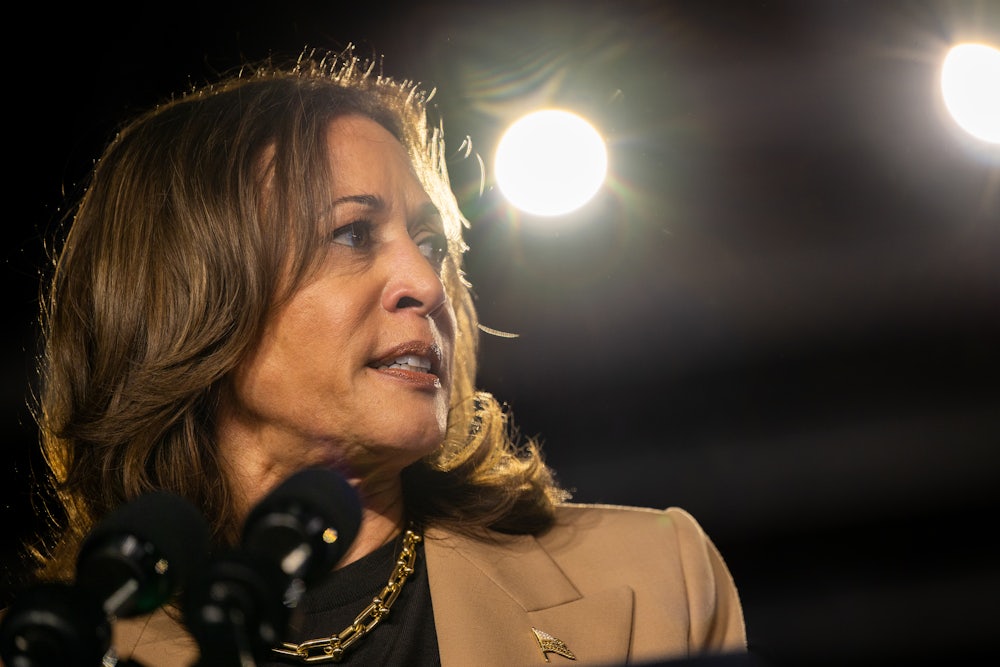Kamala Harris currently retains a very slight edge over Donald Trump in this election. But Trump could still very well win, and when Democrats privately discuss how they got to this moment—and how to avert catastrophe—they tend to focus on a few big dynamics. One is still fixable. The others may not be.
Some Democrats worry, for instance, that the party still isn’t doing enough to engage low-propensity Black and Latino voters, particularly young men. There is time to repair this. Democrats also wonder if they failed to define Trump early in the cycle, letting him slowly rehabilitate his favorability numbers. Still others fear they didn’t remind voters early on of the horrors of Trump’s first term, leaving them with rosy memories of his presidency—including blue-collar voters’ fond impressions of the Trump economy. Those latter two problems may not be repairable in time.
All this is why some Democrats are now second-guessing some of the moves made by the most powerful pro-Harris Super PAC, Future Forward. Last year, the group secured the blessing of President Biden and his senior advisers, making it the top repository for big contributions from the party’s wealthiest donors. The PAC—which has a budget of hundreds of millions of dollars—is a highly influential actor in setting national messaging against Trump, and in determining how an immense pool of party resources will be distributed to broadcast it.
But there is rising urgency about Future Forward’s strategy in the closing days of the race, according to numerous Democrats from other party-aligned organizations. They fear the PAC has still done too little to reach low-engagement nonwhite voters, both by failing to put enough resources into targeted digital advertising—as opposed to traditional TV and broadly focused digital ads—and by being slow to share resources with groups experienced in mobilizing these voters.
There is still time to fix this problem, many of these Democrats say, and the PAC’s resource sharing has improved in recent days. But time is running out.
“I am grateful that they have begun to disperse money to groups so we can help people mobilize and make plans to vote,” Tatenda Musapatike, CEO of the Voter Formation Project, which does outreach to Black and Latino voters, told me. “But Future Forward can do more in reaching less-engaged voters of color, particularly through digital programming.”
Last month, several Democratic groups circulated a memo warning that Trump is peeling off support among those constituencies. The memo concluded that underinvestments in digital communications with those groups was a major problem.
But it turns out that a good deal of this angst was directed at Future Forward in particular. Democrats familiar with internal party communications say that the PAC—which had been widely viewed as a conduit for former White House adviser Anita Dunn to exercise influence over party messaging and resources—is operating from too traditional a mindset.* The PAC, they say, favors ads on broadcast television aimed at broad audiences—when reaching young and nonwhite voters requires a more targeted digital approach because their media sources have grown so fractured.
“You’ve got one Super PAC swimming in so much cash, alongside dozens of groups with long-standing expertise on the voters that are going to carry us this victory,” a senior Democratic strategist at a group that sometimes works in tandem with Future Forward told me. “This one-size-fits-all media strategy from Future Forward should alarm Democrats in the final stretch.” Other groups doing this outreach and would benefit from more resources, Democrats say, include BlackPAC and Won’t PAC Down.
Some Democrats pointed to communication problems with Future Forward that, they insist, are hampering outreach to these constituencies. They say the PAC has given too few briefings to other groups about what its internal data shows—Future Forward has ample resources for research that others lack—and when they’ve asked the PAC for data-based guidance, they get limited responses.
Future Forward—which is led by strategist Chauncey McLean and stays out of the media spotlight—says it absolutely is focused on targeting core constituencies. A Democrat familiar with the Super PAC’s thinking pointed out that it is currently running a heavily backed ad featuring a Black, blue-collar narrator talking about Trump’s tax cuts for the rich. Future Forward believes this kind of ad reaches both demographically targeted and general audiences and thus is a good use of resources.
The Super PAC is also running ads on Black radio across the battleground states, and 50 percent of the group’s TV ad dollars are going to markets with a 20 percent Black population or higher. Future Forward’s TV ads are also heavily oriented toward programming that has high reach with African American audiences.
But the key question is whether conventional TV ads, even those geared toward markets with many nonwhite voters in them, is enough. The critics say an approach aimed right at nonwhite voters—with a message that speaks directly to them—is needed.
“It’s not sufficient to assume that it will be enough to target a broadcast universe with some nonwhite voters in it,” the senior Democratic strategist says. “These voters need to be specifically targeted.” The Bulwark recently reported that Democratic data shows that such directly targeted communications constitute a very small percentage of party messaging.
On the claim that Future Forward isn’t spreading money around, the Democrat familiar with the PAC’s thinking noted that the PAC has launched multimillion-dollar targeted campaigns with groups like Somos Votantes and Unidos, which target Latino voters. Another ad partnership targets younger women, and still another is aimed at Asian American and Pacific Islander voters. The PAC also claims to have initiated the largest ad push on YouTube in political history, with the exception of the Harris campaign itself.
At bottom, all of this represents principled, fundamental, intraparty disagreement over how best to deploy resources. But the bottom line is that, as of right now, Harris is still not winning young and nonwhite voters in quite the numbers she needs.
Meanwhile, some Democrats say that the PAC didn’t put enough resources into early ads defining Trump—and reminding voters about the disasters of his first term. One episode in particular rankles: When Biden dropped out of the race in late July, many groups urged Future Forward to go up on the air immediately, and were dismayed when days dragged by without any launch. “People were freaking out,” one Democratic operative in the constellation of outside Dem-aligned groups said. “The frustration really came out into the open.”
In fairness to Future Forward, the PAC went up with positive biographical ads about Harris six days after Biden’s exit. But to critics, that was five days too many. In their view, Future Forward spends too much time testing ads before running them, and here it cost the PAC crucial time at a critical moment.
This too centers on a principled, fundamental intraparty disagreement. Future Forward genuinely believes in deep testing of ads before airing them, because political operatives—who are partisans—are often bad judges of how swing voters will view ads. But critics fear that has rendered the PAC “slow to deploy resources,” as they put it.
Meanwhile, on the timing of ads there is also a fundamental intraparty disagreement. According to the Democrat familiar with Future Foward’s thinking, the PAC genuinely believed in the early days of Harris’s campaign that siphoning resources away from later spending would not have been a worthwhile tradeoff, because ads placed when voters are really tuned in get more for the money. But several critics noted that defining Trump early—as Democrats did successfully against Mitt Romney in 2012—is central to the role of Super PACs like Future Forward.
In this regard, some Democrats pointed to an analysis that Future Forward sent to other groups that warned against too much use of footage of Trump in ads. The guidance said such footage must include “context” and that much of the time, footage of “Trump speaking often helps him, not us.” Fairly or not, some Democrats read this as a sign that the PAC largely sees focusing on Trump’s debased public displays as a strategic nonstarter.
Yet as this reticence has persisted, Trump’s favorable ratings are now higher than they arguably should be—they’re at 46 percent—potentially a big obstacle to defeating him. So something is clearly wrong.
Meanwhile, Trump’s persistent advantage on the economy—especially with critical non-college white voters—does suggest a failure to remind people of his first-term economic catastrophe. “We missed the early window to adequately define his economic failures,” the Democratic strategist at another group says.
At bottom, all these disputes represent larger internal arguments over why Trump is so close to winning despite the good economy, Harris’s strong debate performance and platform aimed at middle-and working-class voters, and Trump’s absurd economic agenda, daily derangement, violent coup, and criminal convictions. These disputes turn on questions that are not at all easy to resolve—ones whose answers we won’t know until after Election Day.
It’s a basic truism of politics that winning campaigns were run by geniuses and losing ones were run by numbskulls. So if Harris wins, Future Forward will appear to have gotten all this right, perhaps brilliantly so. But if she loses, the recriminations—not just directed at Future Forward, but all throughout the party—will be severe.
* This article originally omitted the fact that Dunn is a former White House adviser.








